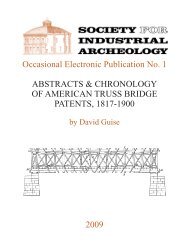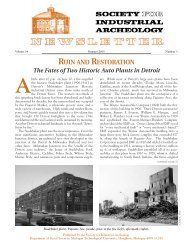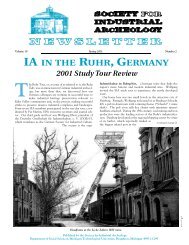birmingham, “pittsburgh of the south,” - Society for Industrial ...
birmingham, “pittsburgh of the south,” - Society for Industrial ...
birmingham, “pittsburgh of the south,” - Society for Industrial ...
You also want an ePaper? Increase the reach of your titles
YUMPU automatically turns print PDFs into web optimized ePapers that Google loves.
Robert Stewart phot1<br />
BIRMINGHAM (continued from page 5)<br />
Little has changed at <strong>the</strong> Empire Coke Works in Holt since <strong>the</strong> plant began operations<br />
in 1903. Here, tour participants examine <strong>the</strong> by-products recovery plant.<br />
Just out <strong>of</strong> view to <strong>the</strong> right is <strong>the</strong> plant’s battery <strong>of</strong> 60 ovens.<br />
1963. The church is also squarely glimpsed through a large window<br />
at <strong>the</strong> institute, where it dramatically punctuates <strong>the</strong> institute’s<br />
excellent historical exhibits.<br />
The traditional Saturday evening banquet provided a refreshing<br />
change <strong>of</strong> pace—a Sou<strong>the</strong>rn barbeque at Rickwood Field,<br />
America’s oldest baseball park. Built by Birmingham industrialist<br />
Rick Woodward in 1910 to serve a booming iron-and-steel town,<br />
Rickwood Field was home to <strong>the</strong> Birmingham Barons (Class A)<br />
until 1987 and, from 1920 to 1963, <strong>the</strong> Birmingham Black Barons,<br />
one <strong>of</strong> <strong>the</strong> most thrilling teams in <strong>the</strong> Negro Leagues. Ty Cobb got<br />
his start here; so did Willie Mays. Today, under <strong>the</strong> direction <strong>of</strong><br />
David Brewer [SIA], Rickwood Field is being restored as a place to<br />
relive <strong>the</strong> magic <strong>of</strong> baseball’s glory years. After a delicious dinner<br />
<strong>of</strong> pork barbecue, coleslaw, baked beans, and pecan and chocolate<br />
cream pie, we enjoyed a panel discussion featuring veteran Black<br />
Barons Donald Harris, Willie Young, and Jessie Ritchie, who<br />
recalled <strong>the</strong>ir experiences both at home and on <strong>the</strong> road. The<br />
evening concluded with a prize giveaway (all items were donated<br />
by companies and organizations featured on <strong>the</strong> tour) and, <strong>for</strong> <strong>the</strong><br />
hardy, an impromptu s<strong>of</strong>tball game played on <strong>the</strong> historic diamond.<br />
Sunday <strong>of</strong>fered a variety <strong>of</strong> options, including a walking tour <strong>of</strong><br />
downtown Birmingham, ably led by local preservation consultant<br />
Linda Nelson. Beginning at <strong>the</strong> <strong>for</strong>mer wholesale district adjacent<br />
to <strong>the</strong> tracks <strong>of</strong> <strong>the</strong> Louisville & Nashville Railroad, Nelson led us<br />
down cobblestone-paved Morris Avenue and through <strong>the</strong> downtown<br />
business district, pointing out both architectural gems and<br />
planning disasters. Much <strong>of</strong> Birmingham’s historic fabric has been<br />
lost to disinvestment and parking lots. Still, <strong>the</strong> size and scale <strong>of</strong><br />
<strong>the</strong> downtown district belies a city <strong>of</strong> just 250,000.<br />
Following <strong>the</strong> walking tour, many continued to <strong>the</strong> Civil War-era<br />
Brierfield Ironworks, <strong>the</strong> Heart <strong>of</strong> Dixie Railroad Museum in<br />
Calera, and Shelby Ironworks Park. Passing on <strong>the</strong> downtown<br />
walking tour and instead opting <strong>for</strong> “Xtreme IA,<strong>”</strong> a second group<br />
enjoyed a vigorous hiking tour <strong>of</strong> abandoned iron-ore sites. Bode<br />
Morin and Bob Yuill led <strong>the</strong> “xtremists<strong>”</strong> over Red Mountain and<br />
through <strong>the</strong> woods to <strong>the</strong> remains <strong>of</strong> Sloss Furnaces’ Ruffner No. 3<br />
mine. The extant mine drifts, slopes, and ore crushers are now part<br />
<strong>of</strong> Birmingham’s Ruffner Nature Preserve, <strong>the</strong> largest<br />
municipally owned park in <strong>the</strong> country. The group <strong>the</strong>n<br />
proceeded to Bessemer, bushwhacking through chesthigh<br />
vegetation to <strong>the</strong> concrete portal and hoist house<br />
(its hoisting drum and electric motors intact) <strong>of</strong> Sloss<br />
No. 2 mine. The extremists <strong>the</strong>n met up with <strong>the</strong><br />
Brierfield group at <strong>the</strong> Heart <strong>of</strong> Dixie Railroad Museum,<br />
where everyone boarded historic Pullman passenger cars<br />
<strong>for</strong> <strong>the</strong> first leg <strong>of</strong> <strong>the</strong> eight-mile trip to Shelby Ironworks<br />
Park. The Calera & Shelby Railroad eventually will<br />
connect <strong>the</strong> two historic sites, but <strong>for</strong> now buses must<br />
meet <strong>the</strong> train halfway to complete <strong>the</strong> journey to<br />
Shelby. There, Jack Bergstresser demonstrated <strong>the</strong> operation<br />
<strong>of</strong> a Catalan <strong>for</strong>ge he built several years ago based<br />
on an article published in <strong>the</strong> 1850s. Used from about<br />
<strong>the</strong> 12 th through 18 th centuries, <strong>the</strong> Catalan <strong>for</strong>ge,<br />
through prolonged heat, removes non-ferrous material,<br />
leaving a relatively pure wrought-iron bloom (in contrast<br />
to <strong>the</strong> indirect process <strong>of</strong> a blast furnace, which completely<br />
breaks down <strong>the</strong> iron ore be<strong>for</strong>e separating it from<br />
<strong>the</strong> slag). Following <strong>the</strong> demonstration, everyone<br />
enjoyed a traditional Sou<strong>the</strong>rn-style supper provided by<br />
<strong>the</strong> Historic Shelby Assn.<br />
Thus ended a rewarding and memorable 1999 SIA<br />
Fall Tour. Dixie did not disappoint.<br />
C.P.M.<br />
To <strong>the</strong> above report, I am pleased to add <strong>the</strong> following postscript<br />
prepared by Bode Morin, who, as chairman <strong>of</strong> <strong>the</strong> 1999 fall tour<br />
committee, did yeoman’s work coordinating tour sites, meals, transportation,<br />
logistics, and finances:<br />
The success <strong>of</strong> Fall Tour ’99 is owed to <strong>the</strong> dedicated volunteers<br />
<strong>of</strong> <strong>the</strong> SIA Sou<strong>the</strong>rn Chapter. Their contributions ensured that<br />
<strong>the</strong> tour ran smoothly. I would particularly like to thank <strong>the</strong> following<br />
<strong>for</strong> <strong>the</strong>ir fine ef<strong>for</strong>ts: David Brewer, as tour co-chair, coordinated<br />
bus routes and schedules, arranged and hosted <strong>the</strong> Saturday<br />
evening banquet at Rickwood Field, and served as a bus guide.<br />
Caryn Hollingsworth, director <strong>of</strong> <strong>the</strong> UAB Anthropology<br />
Laboratory, served as treasurer and registration manager. Jack<br />
Bergstresser, UAB pr<strong>of</strong>essor <strong>of</strong> archaeology, wrote and produced<br />
(with assistance from Nick Kouchoucos) “The Merchant Foundry<br />
Iron Blast Furnaces That Made <strong>the</strong> Birmingham <strong>Industrial</strong> District<br />
Unique, 1876-1930,<strong>”</strong> distributed to tour participants. He also produced<br />
<strong>the</strong> handsome four-color souvenir map, “Ironmaking<br />
Systems <strong>of</strong> <strong>the</strong> Birmingham District circa 1928,<strong>”</strong> coordinated tours,<br />
and served as a bus guide. Ron Bates and Ruth Helms coordinated<br />
registration. Jack Moore, Garnet Garvin, and Rosie O’Beirne<br />
served as bus managers, Sarah Cowie and Bob Yuill as tour coordinators.<br />
Catharine Crowell created <strong>the</strong> logo and nametags. Jill<br />
Miller created <strong>the</strong> registration database. John Brasher, president <strong>of</strong><br />
<strong>the</strong> Historic Shelby Association, hosted <strong>the</strong> group at Shelby Iron<br />
Works Park. Marty Everse and Vicky Gentry hosted <strong>the</strong> group at<br />
Tannehill and arranged <strong>for</strong> Jim Bennett to facilitate <strong>the</strong> U.S. Steel<br />
Fairfield tour. Mike Mahan hosted <strong>the</strong> group at Brierfield Furnace.<br />
Linda Nelson conducted <strong>the</strong> architecture walking tour. Julie<br />
Hamilton provided hors d’oeuvres <strong>for</strong> <strong>the</strong> Friday evening board<br />
meeting, and Ralph Pierson arranged our visit to <strong>the</strong> Heart <strong>of</strong> Dixie<br />
Railroad Museum and <strong>the</strong> train to Shelby. Finally, I would like to<br />
thank <strong>the</strong> Birmingham Convention and Visitors Bureau <strong>for</strong> providing<br />
registration materials and volunteer support, as well as each<br />
<strong>of</strong> <strong>the</strong> many companies that opened <strong>the</strong>ir doors to us so graciously.<br />
6 <strong>Society</strong> <strong>for</strong> <strong>Industrial</strong> Archeology Newsletter, Vol.28, No. 4, Winter 1999<br />
B.M.






